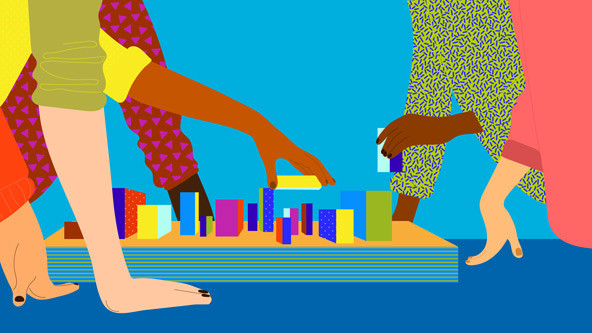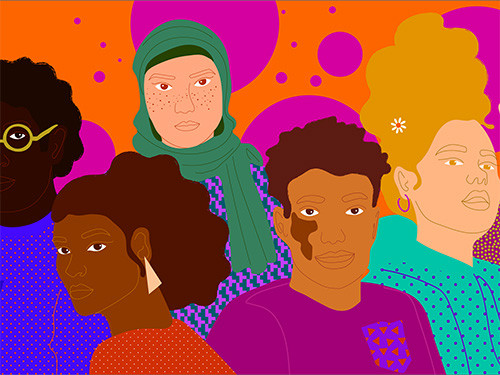 (Illustration by Aurélia Durand)
(Illustration by Aurélia Durand)
What makes cities such as Paris, New York, and Rio de Janeiro beloved places? They have developed distinct identities that are shaped and transformed by the people who live there and contribute to a high quality of life. But ensuring that places remain inclusive, without compromising the rich diversity that comes with living in cities, is not simple. It requires that growth and development in cities and communities happen equitably. Therefore, the way we think about planning, designing, and using places is important both locally and globally.
People want to live in vibrant places with promising social and economic opportunities. Public spaces become activated as places when they are accessible, sociable, comfortable, and filled with activity. It is the sense of being lived in and utilized. Places shape how we experience cities and the interactions we have within them. Local leaders across the globe have been thinking about ways to build thriving communities that foster equitable development and social inclusion. As cities become more diverse—economically and racially—it is increasingly necessary to ensure places and the people who live there are not isolated or displaced.

Placemaking has become an important tool in the community development toolbox to revitalize disinvested, underutilized areas to attract people and activities. The Project for Public Spaces defines it as the process of collaboratively creating places that are meaningful to a community and that enhance people’s quality of life. Placemaking is about fostering a sense of belonging in a place and providing the community an opportunity to define its use. When done effectively, it can help strengthen local economies, reduce crime, drive civic engagement, and improve health and well-being.
But building community assets can sometimes have unintended consequences: They can be underutilized or benefit only a small segment of the community. They can increase the desirability of living in the community, which can price out those who already live there. Low-income communities and communities of color are especially vulnerable to gentrification and the displacement and concentrated poverty it generates.
To avoid such problems, placemaking activities must be done equitably by ensuring that the whole community is involved in the process and benefits from the results. Fortunately, there are many examples of success nationwide and around the world.
Realizing Community Priorities
Fostering strong community-level participation is critical for equitable and inclusive development. A 2017 PolicyLink report on equitable development and culture emphasizes the importance of community development that does not stifle creativity, leave people behind, displace people, or lead to a homogeneous community. When placemaking efforts such as developing neighborhoods parks and installing public art include equitable development practices, neighborhoods and cities can remain vibrant and inclusive, and encourage a sense of belonging.
Facilitating community engagement in the development of parks and open spaces is crucial. A 2016 RAND study of US neighborhood parks found that even when parks are built in low-income communities and communities of color, use of the asset might be limited if park development does not include the residents input in the planning process. When the community helps to create the park space, residents take ownership and better utilize it, and park programming and amenities better mirror the community’s priorities. Parks departments in Miami-Dade County and Denver, and nonprofits in Washington, DC have developed neighborhood advisory committees to facilitate these decision-making processes. In Miami-Dade County for instance, these committees have meetings in both English and Spanish to encourage all residents to participate.
Some parks departments have also adopted equitable programming. To eliminate barriers to access, parks are offering free activities, fitness classes, and performances to incentivize the entire community to participate and utilize the space. Community-based organizations, churches, schools, and community centers have participated to ensure residents’ priorities are included in the planning, programming, and maintenance of open space. Without community consultation and buy-in, local leaders are less likely to make decisions that benefit the residents and primary users of the space.
Addressing Historic Inequities
Investments in communities and neighborhoods can boost economic activity, but they are often not sufficient to build wealth equitably for their residents. Effective placemaking activities must ensure investments serve as assets for existing residents without adding the pressure of displacing them or pricing them out. This balancing act can be challenging, but when done right, placemaking can catalyze growth for low-income neighborhoods and communities of color.
Local leaders across the United States have used place-based efforts to help distressed communities regain market strength and to stimulate economic growth in places experiencing blight, but their work confronts persisting structural inequalities. Racial equity is a key driver in understanding the disparities surrounding access to wealth, health, housing, and education. For instance, historic housing discrimination through federal lending and investment policies have limited people’s access to places and amenities, and contributed to racially segregated neighborhoods. Even without formal barriers, there are subtler methods that exclude residents by wealth rather than skin color, but these still lead to unequal access to opportunities for people of color striving to build wealth. The complexity of these racialized forms of exclusion have persisted in places such as Baltimore, Detroit, and Philadelphia.
Much of the spatial and economic segregation within neighborhoods—particularly in large metro areas—derives from redlining, the discriminatory practice of denying credit-worthy applicants housing loans in specific places. Federal mortgage programs, housing and development programs, and real estate boards upheld the systemic disinvestment and impoverishment of neighborhoods of color. These discriminatory lending practices have left a legacy of disinvestment, predominately in black and brown communities. Although the Community Reinvestment Act of 1977 sought to tackle these disparities by requiring neighborhood investment, the legacy of housing segregation and disinvestment remains.
Placemaking has helped deliver approaches to address historic inequities and generate inclusion. In Detroit, local leaders have used strategic placemaking to encourage talent and economic renewal for local communities. Studies show that the economic impact of a dollar spent at a local business is three times higher than a dollar spent at a chain retailer. To unlock opportunities, Detroit invested city dollars, through placemaking efforts, to revitalize distressed neighborhoods and spur growth for black-owned businesses. Partnerships and collaboration with the community members, such as the Strategic Neighborhood Fund initiative, have been key for the city’s resurgence, and these have been centered on entrepreneurship and small business development in communities of color.
A Global Movement
These efforts are not only occurring within the United States. In cities with rapid growth and spatial expansion, municipal leaders are seeking to preserve people, culture, and places. For instance, in East Asian cities such as Beijing, Jakarta, and Manila, which are experiencing some of the highest rates of urbanization in the world, officials are using placemaking approaches to encourage equitable access to infrastructure and basic services. National governments often drive planning decisions in East Asia, but placemaking efforts offer an opportunity for local communities to participate in the design and plan of public spaces and amenities.
In Solo, Indonesia, the national government sought to address the risk of residents living close to the Bengawan River after catastrophic floods there in 2007. After resettling them, the government collaborated with the community to repurpose the vacated land with activities to encourage economic mobility. They developed green space with recreational infrastructure and community gardens, which nearby residents have used to grow plants to make oils for commercial sale. Including community members in determining how to activate the space, not only ensured a reduction in the disaster risk, but also strengthened the local community’s relationship to their home. This demonstrates one way for the government to build on the community’s priorities for the place and also drive economic mobility for those who live there.
Equitable places are scalable and there are general tools that demonstrate the link between place and race. For instance, equity mapping identifies assets and opportunities for communities to inform policymakers on how to invest resources in underserved places. Similarly, participatory planning tools, such as complete streets and participatory budgeting, position community residents as the primary decisionmakers to determine the design and funding allocations for where they live.
There are lessons for policymakers and community developers to address the barriers to racial equity and inclusion at the local level, which in turn can shape global identity. Placemaking can be effective in bringing together the community as primary beneficiaries for development. To promote its use, the field should invest in more instruments for measuring the impact of place-based activities, and encourage local leaders to put more funds into this community development approach. With considered and inclusive planning processes, placemaking can not only revive our cities, but also improve the lives of all their residents.
Support SSIR’s coverage of cross-sector solutions to global challenges.
Help us further the reach of innovative ideas. Donate today.
Read more stories by Kimberly Burrowes.

